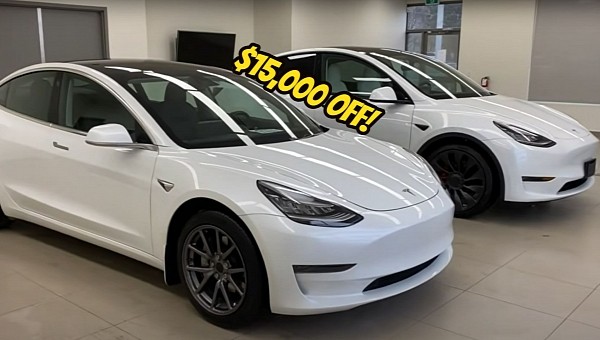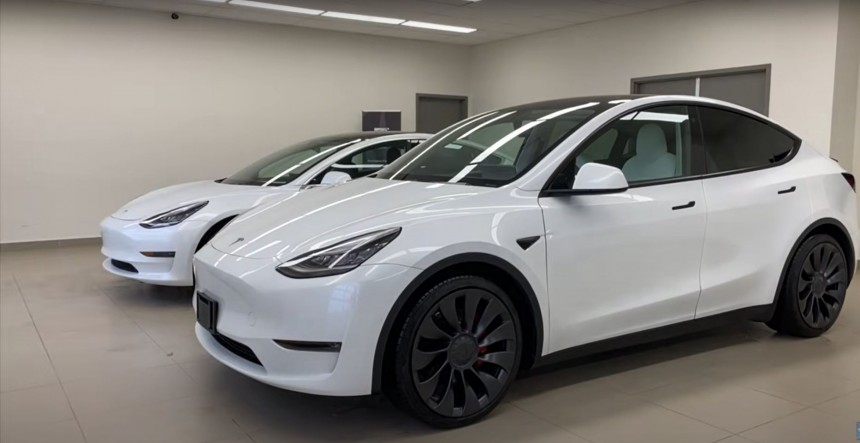Now that’s a proper discount, right? Well, the thing you should know about it is that the price reduction is official only after the federal tax credit and the state rebate are combined. Also, there are a couple of eligibility rules. Let’s see who gets to buy a Tesla for a massively attractive cost.
Back in 2016, Elon Musk said that “there can never – and I mean never – be a discount on a new car coming out of the factory in pristine condition.” The executive might have discovered that the EV maker’s quality control is not top-notch, so this year began with some serious price cuts. Overnight, the Model 3 Performance became $9,000 cheaper, while the Model Y Long Range’s cost shaved off $13,000.
After a couple of surprising adjustments, the price for a base Model 3 Rear-Wheel Drive currently sits at $42,990, while the cheapest Model Y Long Range costs $54,990. The latter is $2,000 more expensive than in January, while the all-electric sedan is now $1,000 cheaper than two months ago.
For Californians, these discounts were great news. Once paired with the maximum EV tax credit and Clean Vehicle Rebate, the pre-tax prices drop to $27,990 for the Model 3 RWD and $39,990 for the Model Y LR.
A year ago today, California decided to exclude Tesla from the Clean Vehicle Rebate Project (CVRP). The program helped the EV maker with gaining popularity in the state since it was implemented because it made the cars cheaper. The administration’s reason for the exclusion was simple – the Model 3 and Model Y became just too expensive. But the brand reapplied after adjusting its prices at the beginning of the current year and the two models are now once again eligible if the order for one was placed on or after January 12, 2023.
The CVRP establishes income limits for individuals who want to access the entire $7,500 rebate. They must earn 400% of the 2022 federal poverty level ($54,360 for a one-person household, for example). Single filers earning a maximum of $135,000 per year will only receive $2,000.
The rebate is offered only once per person and interested parties must apply within 90 calendar days of the purchase or lease date. Businesses, nonprofits, and government entities can also apply for CVRP. It's how California wants to support everyone in ditching the dirty internal combustion engine in favor of cleaner powertrains.
The other helping hand comes from the federal government through the updated clean vehicle credit (better known as the EV tax credit). This is how those interested in buying a new Tesla get the opportunity to receive another $7,500. But instead of a rebate that takes the form of a check, the EV tax credit can only be used to lower tax liability. This means you must owe the federal government at least $7,500 so you can take advantage of the full amount. If that’s not the case, the money is lost. The surplus cannot be used for the next tax year.
There are some limitations here as well that must be known. Applicants must buy an eligible vehicle that meets the cost cap, and earn $150,000 tops for individual filers or $300,000 for married couples filing jointly.
But the Inflation Reduction Act (IRA) established some restrictions for manufacturers in an attempt to secure more investments in the U.S. One of these regulations revolves around the critical minerals used in batteries. Since China’s CATL currently holds 34% of the global EV battery market, it’s understandable why the IRA was a bipartisan success. Lawmakers want more money flowing into the U.S. and new jobs to be created.
The Treasury is expected to release the EV battery sourcing rules by the end of the current month, which may reduce the EV tax credit amount in half. That’s because the manufacturers must put batteries into their all-electric vehicles that have 40% of the minerals coming from inside the U.S. or from countries with which America has a free trade agreement active.
Finally, that’s how Californians who take delivery of a Tesla Model 3 or Model Y before the Treasury confirms the battery sourcing rules and meet all the other criteria obtain an EV that is $15,000 cheaper once the check from CVRP comes in and the taxes for the current year are filed in 2024 with the EV tax credit included.
But if the Treasury establishes a rule that forces Tesla to admit that most of the critical minerals it uses come from China, then that price reduction may be lowered to $11,250.
After a couple of surprising adjustments, the price for a base Model 3 Rear-Wheel Drive currently sits at $42,990, while the cheapest Model Y Long Range costs $54,990. The latter is $2,000 more expensive than in January, while the all-electric sedan is now $1,000 cheaper than two months ago.
For Californians, these discounts were great news. Once paired with the maximum EV tax credit and Clean Vehicle Rebate, the pre-tax prices drop to $27,990 for the Model 3 RWD and $39,990 for the Model Y LR.
A year ago today, California decided to exclude Tesla from the Clean Vehicle Rebate Project (CVRP). The program helped the EV maker with gaining popularity in the state since it was implemented because it made the cars cheaper. The administration’s reason for the exclusion was simple – the Model 3 and Model Y became just too expensive. But the brand reapplied after adjusting its prices at the beginning of the current year and the two models are now once again eligible if the order for one was placed on or after January 12, 2023.
The CVRP establishes income limits for individuals who want to access the entire $7,500 rebate. They must earn 400% of the 2022 federal poverty level ($54,360 for a one-person household, for example). Single filers earning a maximum of $135,000 per year will only receive $2,000.
The rebate is offered only once per person and interested parties must apply within 90 calendar days of the purchase or lease date. Businesses, nonprofits, and government entities can also apply for CVRP. It's how California wants to support everyone in ditching the dirty internal combustion engine in favor of cleaner powertrains.
There are some limitations here as well that must be known. Applicants must buy an eligible vehicle that meets the cost cap, and earn $150,000 tops for individual filers or $300,000 for married couples filing jointly.
But the Inflation Reduction Act (IRA) established some restrictions for manufacturers in an attempt to secure more investments in the U.S. One of these regulations revolves around the critical minerals used in batteries. Since China’s CATL currently holds 34% of the global EV battery market, it’s understandable why the IRA was a bipartisan success. Lawmakers want more money flowing into the U.S. and new jobs to be created.
The Treasury is expected to release the EV battery sourcing rules by the end of the current month, which may reduce the EV tax credit amount in half. That’s because the manufacturers must put batteries into their all-electric vehicles that have 40% of the minerals coming from inside the U.S. or from countries with which America has a free trade agreement active.
Finally, that’s how Californians who take delivery of a Tesla Model 3 or Model Y before the Treasury confirms the battery sourcing rules and meet all the other criteria obtain an EV that is $15,000 cheaper once the check from CVRP comes in and the taxes for the current year are filed in 2024 with the EV tax credit included.
But if the Treasury establishes a rule that forces Tesla to admit that most of the critical minerals it uses come from China, then that price reduction may be lowered to $11,250.







